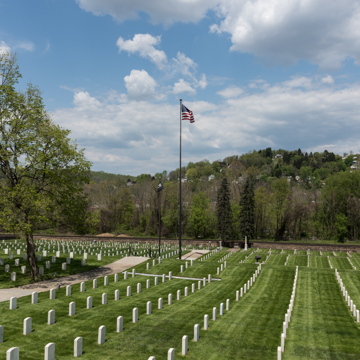Although West Virginia was born of the Civil War and witnessed action during the conflict, this stone-walled, three-acre square is the state's only national military cemetery. Because Grafton was an important rail center, both armies wanted it, and Union and Confederate forces each captured and held the city in turn. The same rail facilities served after the war to transport bodies from temporary graves all over the state to be reinterred here. As in all national cemeteries, uniform white marble tombstones—rectangular with arched heads—are arranged in military precision. Private Thornbury Bailey Brown, the first Union fatality of the war, is among the 1,215 Union soldiers buried here. Of the headstones, 664 are inscribed “Unknown.”
The original superintendent's lodge was a small, one-and-one-half-story, L-shaped building with a dormered mansard roof, built from standard designs that Quartermaster General Montgomery Meigs provided for military cemeteries throughout the country. Constructed of ashlar stone, it was demolished in 1957.










